Do Online Sales Funnels Work? (A Non-BS Guide for All the Haters)

Have you ever been skeptical of something new?
Maybe you take the same road home from work every day, even though a shorter route just opened up.
Or you’ve been buying that same brand of peanut butter for decades when there are clearly superior and healthier options.
You see, as humans, we’re hardwired to be wary of the unknown.
But as a business owner, it’s in your best interest to push back against that tendency.
And online sales funnels are a perfect example of that.
You see, years ago, most people thought online marketing funnels were all a bunch of hype.
Automatically attract and grow leads without any work on your part after setting up your funnel?
Impossible!
But these days, successful business owners have used online sales funnels to grow their businesses and generate leads and sales while they sleep.
And yet, some people still don’t believe they actually work .
Today I’ll show you why online sales funnels aren’t just hocus pocus. With this article, you’ll learn:
- The top 3 key ingredients any successful online sales funnel needs in order to succeed.
- A host of statistics that prove online marketing funnels work (and why they work in the first place).
- And 4 real-life examples of businesses that have used online sales funnels to grow and thrive.
All right, let’s jump right into online sales funnels and explore if this whole thing is legit...
If you want to take the guesswork out of creating high-converting landing pages, ads, and more marketing tasks by using a battle-tested Swipe File of digital marketing examples from million-dollar companies, then you have to
So… What Exactly Is an Online Sales Funnel?
Whelp, in case you’ve been sleeping under a rock for the past years, let’s first define what an online sales funnel is.
An online sales funnel is a series of steps that attracts prospects, leads them towards a purchase decision, and works to convert or upsell them.
A sales funnel can be a simple set of steps like this…
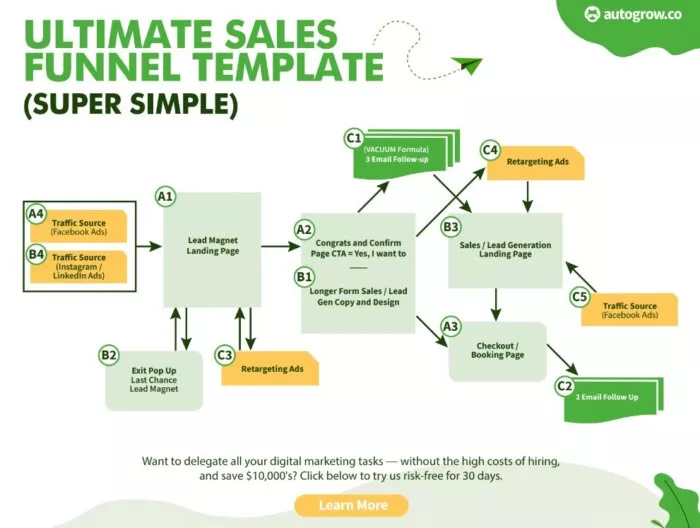
Or it can be more advanced and complex like this…
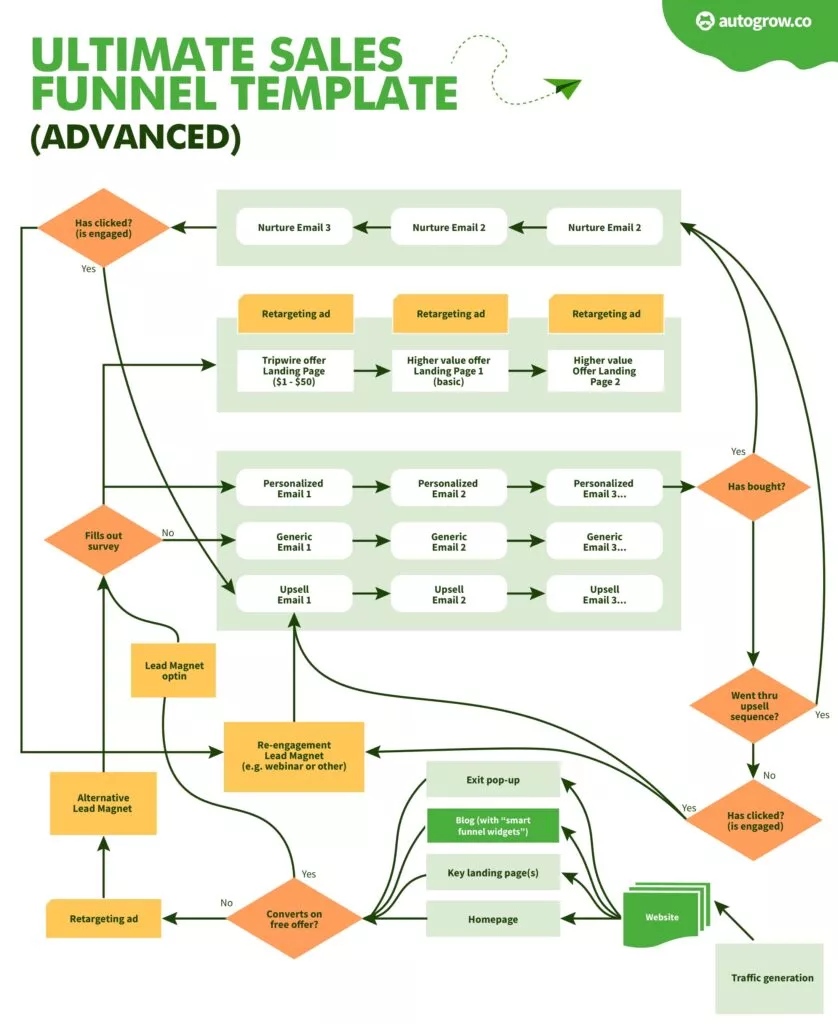
In the end, both types of sales funnels are simply meant to walk prospects through the entire buyer’s journey without you having to do any of the work.
Sounds pretty great, right?
There are many sales funnel templates you can download for free.
With a well-made sales funnel, you can continue to generate new leads and sales while you focus on growing your business, providing great service, or upgrading your products instead of spending all your time marketing.
Now, we’ve put together some great examples of sales funnels in the past.
But for the rest of this article, I’m going to focus on showing you how online sales funnels (sometimes also called marketing funnels) work and how they get actual results.
What Makes Online Sales Funnels Different from a Website?
Truth be told, a lot.
In basic terms, a website is a chunk of information your prospects can look at at their leisure.
They can check out your services, browse your product catalog, and choose to contact you there when they’re ready to buy.
It provides your prospects more of a go-at-your-own-pace experience.
But an online sales funnel is something much more complex.
It’s a set of lead magnets, landing pages, sales pages, emails, and more—all designed to push prospects from one step to the next.
And when prospects enter your online sales funnel, they’re only ever moving closer to buying your product or service.
Here’s a cool visual to help explain what an online sales funnel is
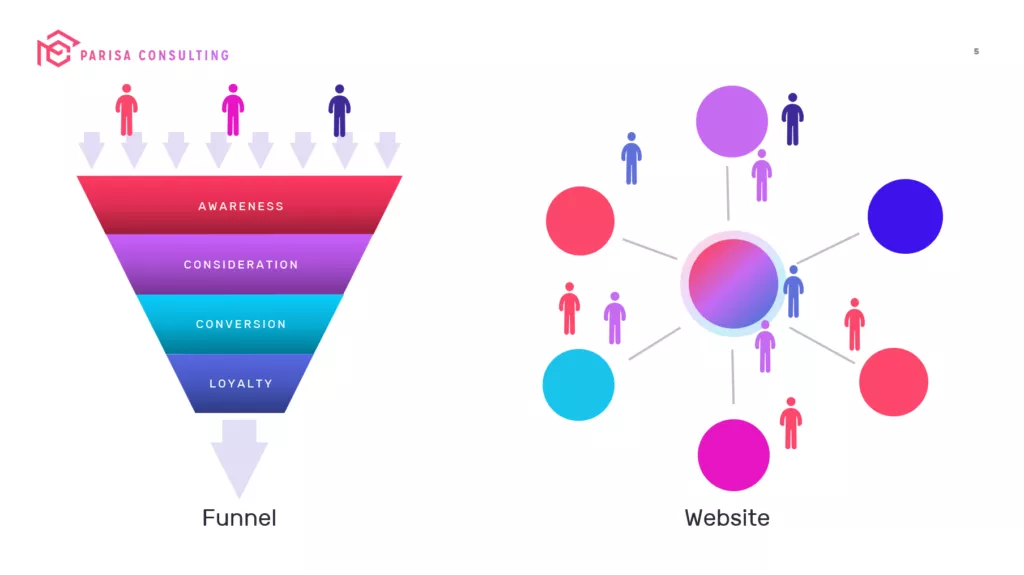
See how with an online sales funnel, prospects are only ever moving down and closer to a sale?

With a website, on the other hand, your prospects can go anywhere they want, even possibly getting further away from buying your product or service.
Think of it like this: a website alone is kind of like an open-world video game.
You can run around and decide to take on quests at your leisure. But for the most part, you can decide where you want to go and what you want to do.
A sales funnel on the other hand is like a linear videogame (or even a movie).
After finishing one part, you are directed to move on to the next. There is only one way to go, and it’s always forward and closer to the end… or in the case of online sales funnels, closer to closing the sale.
See how that works?
Now, a website often is part of an online sales funnel.
But it’s just one piece of the online sales funnel puzzle.
What Are the Key Ingredients for Any Successful Online Sales Funnel?
Every successful online sales funnel is made up of several key ingredients.
We call these key ingredients the three “F’s”.
They are (from the top of the funnel to the bottom) fuel, foundation, and follow-up.

- Fuel – This is where fresh and unqualified leads first enter into your online sales funnel. They’re typically attracted by an appealing offer. It could be a tempting and free lead magnet. Or simply the promise that you’ll be delivering them quality content chock full of valuable information. Many of the funnels we’ve built for our clients are fueled by Google PPC ads or ads through Facebook.
- Foundation – This is where the real magic happens. The foundation section of your funnel is where leads move through the majority of their buyer’s journey. Here, they learn about your product or service, discover your business’ unique selling proposition (USP), and ultimately are convinced to give you their money.
- Follow-Up – Not all leads are going to move smoothly from one step of your funnel to the next. And not all leads are going to be ready to make a purchase decision right off the bat. That’s where the follow-up stage comes in. This part of the funnel is meant to redirect leads who have exited your funnel and bring them back into the sales process. Retargeting ads and email campaigns make up the bulk of this stage.
The 3 stages should also be implemented in this order: foundation, follow-up, and fuel.
Think of it like building a car.
First you need to create the core structure and frame that holds everything together. That’s the foundation.
Then you need to add in all the components that keep the engine’s power flowing through a closed system so you can actually drive. That’s the follow-up.
And finally, you need to give that brand new car the fuel it needs to take off. You guessed it: that’s the fuel.
How Do Online Sales Funnels Work?
Building a successful online sales funnel takes strategy.
But when done correctly, it can lead to a marketing machine that practically runs itself.
See, the great thing about a well-made online sales funnel is that once you’ve put together the foundation and follow-up, you can actually tweak the quantity of leads you bring in simply by altering the traffic source.
Want 25% more quality leads next month? Increase your online funnel’s fuel by 25%.
Want fewer leads to give your team time to focus on developing a new product? All it takes is reducing how much money you invest into your online sales funnel’s traffic source.
It’s as simple as that.
As long as the quality of the traffic is maintained, your ability to grow sales and profits is directly related to your ability to grow traffic.
Now, the trick is arranging your sales funnel into a system of carefully laid out steps. Most of the online sales funnels we’ve designed all start with a lead magnet (like a free checklist, guide, or quiz).
You can also use your existing website as the foundation too.
But in our experience, developing landing pages with a singular focus (i.e., moving leads to the next step) is better than just using your website since the choices are more limited.
That being said, elements of your website (like your blog) could be a great source of traffic to consider using to fuel your online sales funnel.
Getting back to it, let’s look at our Ultimate Sales Funnel Template as an example.
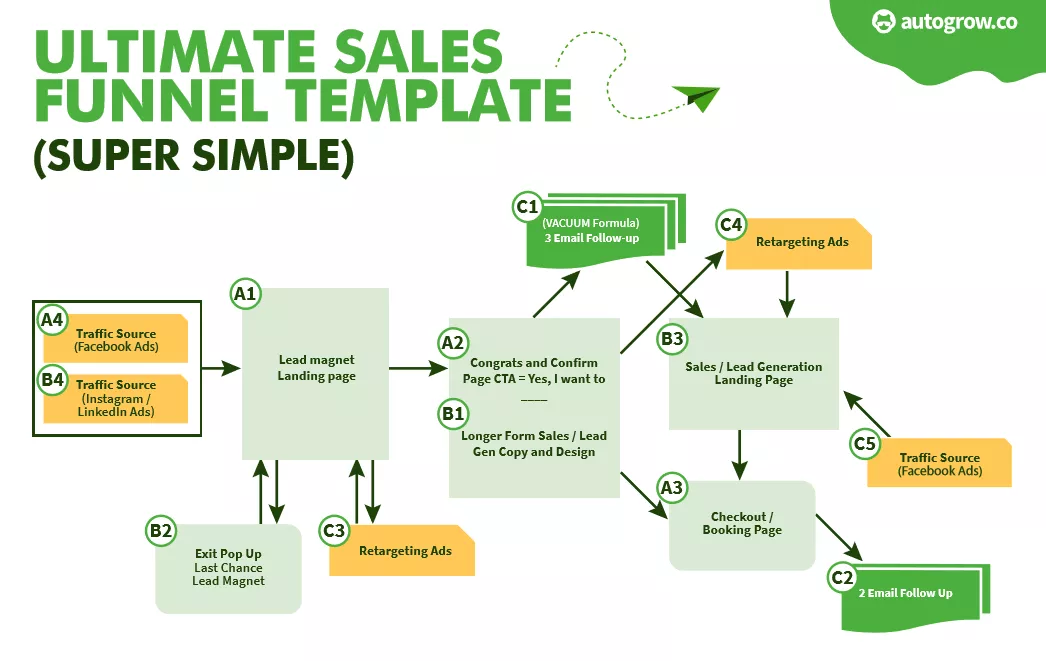
As you can see, the foundation of a funnel doesn’t have to be complicated.
In this funnel template, the way leads flow through the foundation pages are as follows:
- Lead magnet landing page
- Congratulations page
- Sales/lead generation page
- Checkout page
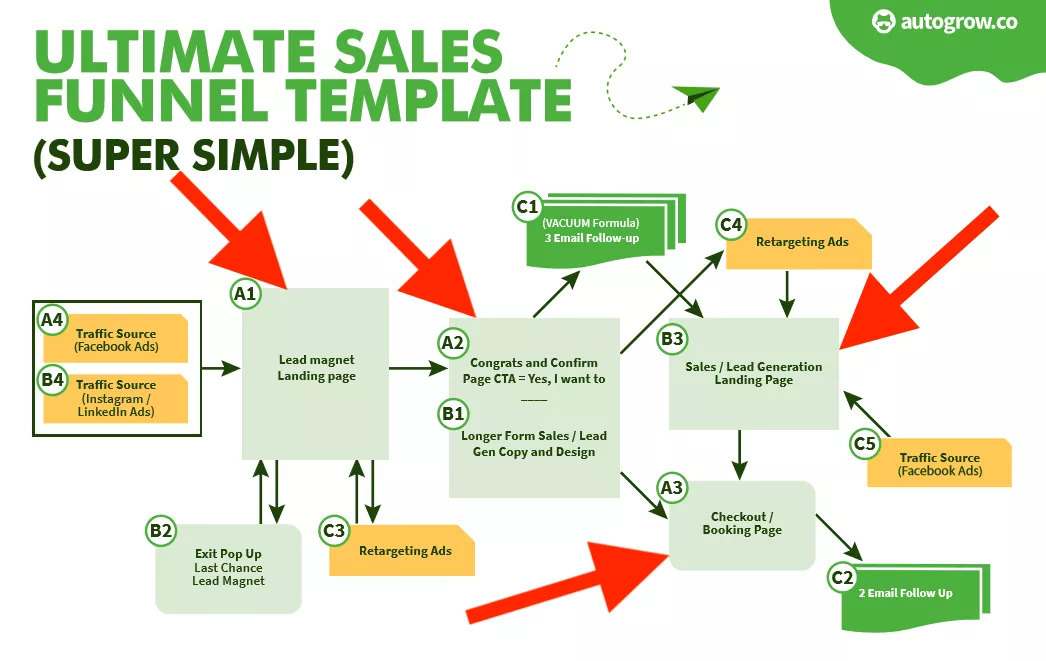
Simple, right?
There are also a number of other sections that are aimed at retargeting ads—those are the follow-up elements.
In this funnel template, these elements include:
- A 3-part email sequence that occurs after prospects have downloaded your lead magnet but not converted on the sales page. This sequence is meant to drive prospects back to the sales page by nurturing the lead and educating them more about what it is you offer.
- Several retargeting ad sections. The first occurs when leads have landed on your lead magnet landing page but not converted on the offer. And the second occurs after leads have exited off of the sales page without converting.
An exit pop-up. This is a powerful way of redirecting prospects who seem intent on, well… exiting off of the page. Sometimes that pop-up may contain a special deal and other times it may re-communicate the benefits of what’s on the page. We’ve found that using lead magnet exit pop-ups (as on the template above) is one of the best ways to keep traffic flowing into your funnel.
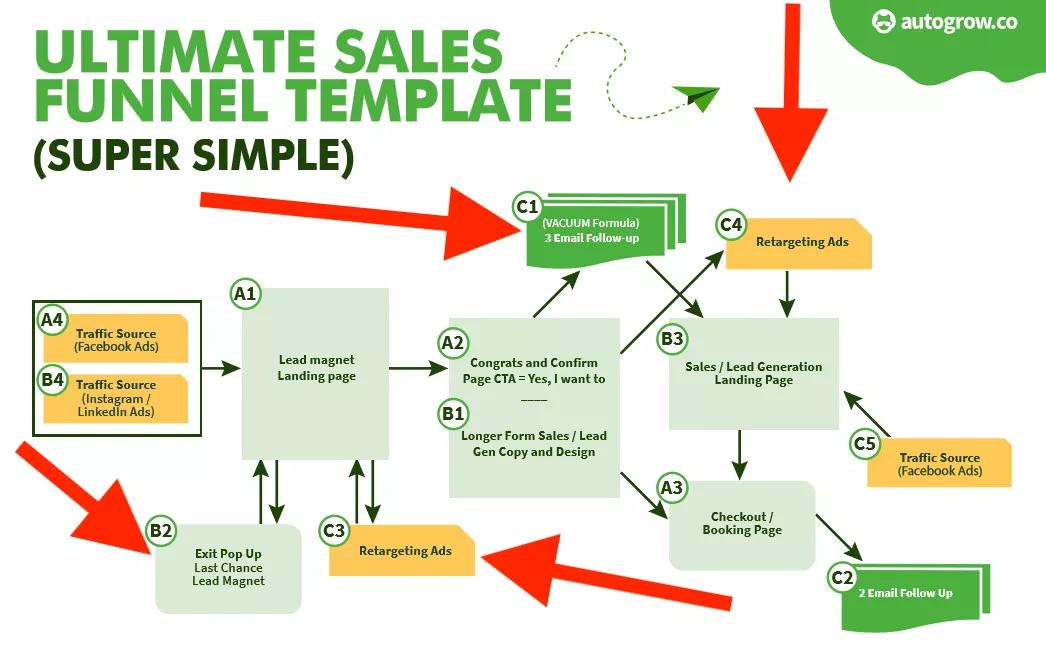
And last but certainly not least, you’ll also see the elements that make up the fuel stage of your online sales funnel.
This template starts out by directing Facebook, LinkedIn, and Instagram ads to your lead magnet landing page.
But there’s also an additional set of ads that lead directly to the sales page too.
Leads that come through this fuel source may not be as qualified because they haven’t seen your lead magnet or been nurtured through your email campaigns.
But in any case, they may still be right for your services (as long as you’ve created compelling advertisements that is).

Now, when you’ve implemented all of the three F’s into your funnel design (as in the template above), your prospects will:
- Be driven into your funnel through ads (fuel).
- Move through your core pages to learn about your product/service and decide that you’re the solution they’re looking for (foundation).
- Be redirected back into the funnel if they haven’t converted on your offer (follow-up).
And best of all, it’s all happened without you having to lift a finger—as long as you’ve implemented it all correctly.
How Sales Funnels Get Results: Stats Proving the Effectiveness of Online Sales Funnels
Now that you know what an online sales funnel is, let’s take a look at a few stats that prove why an online sales funnel really works. And they work for agency sales funnels, eCommerce sales funnels, coaching sales funnels, SaaS sales funnels—and pretty much any other funnel.
Upselling Gets Better Results Than Cross-Selling in eCommerce
These days, it’s not enough to simply get new customers or clients. You also need your existing customers or clients to continue to buy from you.
And you can get better results by upselling and cross-selling, which are additional ingredients you can add to your sales funnel.
You may recall that the difference between upselling and cross-selling is that upselling tries to offer a higher end product than the one in question (think: “Do you want to ‘super-size’ your Big Mac?”).
Cross-selling on the other hand is all about offering complementary products in addition to the one(s) being considered (think: “Do you want fries and a coke with that hamburger?”).
Check out this example here.
According to Shopify, behavioral analysis company PredictiveIntent published an interesting study back in the day.
The company discovered that cross-selling is not as effective as upselling on eCommerce sites.
How much less effective you ask?
Well, see for yourself...
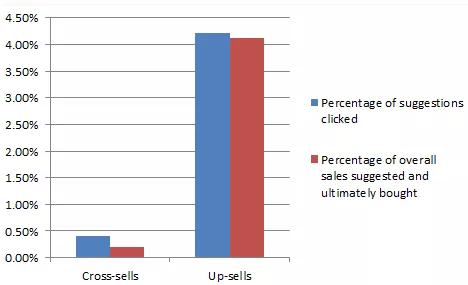
PredictiveIntent sampled their own clients and found that sales were at just 0.2% through cross-selling and up to 4% through upselling. That makes upselling an alternative that’s 20 times more efficient.
And what is one of the best ways to upsell clients? With automated email and retargeting follow-up.
Now, once you have your basic online marketing funnel in place, you can refine it over time so that you’re not only targeting new leads, you’re reaching out to past customers and clients as well.
So try adding a new email campaign that shows past customers the value of your higher-tiered products.
And now that you’ve already gotten over the hardest part of selling (convincing customers and clients to spend money with you), it’ll be substantially easier to sell them on your higher-ticket items.
Ultimate Marketing Automation Statistics Reveal Surge in Use of Automation
The following stats from EmailMonday’s Ultimate Marketing Automation Statistics report prove how the use of marketing automations like online sales funnels is surging.
Here are the key findings from the report:
- The US marketing automation software industry is expected to be $25.1 billion in 2023 according to Statista.
The global marketing automation software market size was valued at $25506.8 million in 2022 according to Linkedin.
- A whopping 76% of marketers now use some form of marketing automation tool in their day-to-day business according to a 2021 State of Marketing report.
- Research from Liana Technologies found that almost 2 out of every 3 businesses pointed to better personalization being the top benefit of marketing automation.
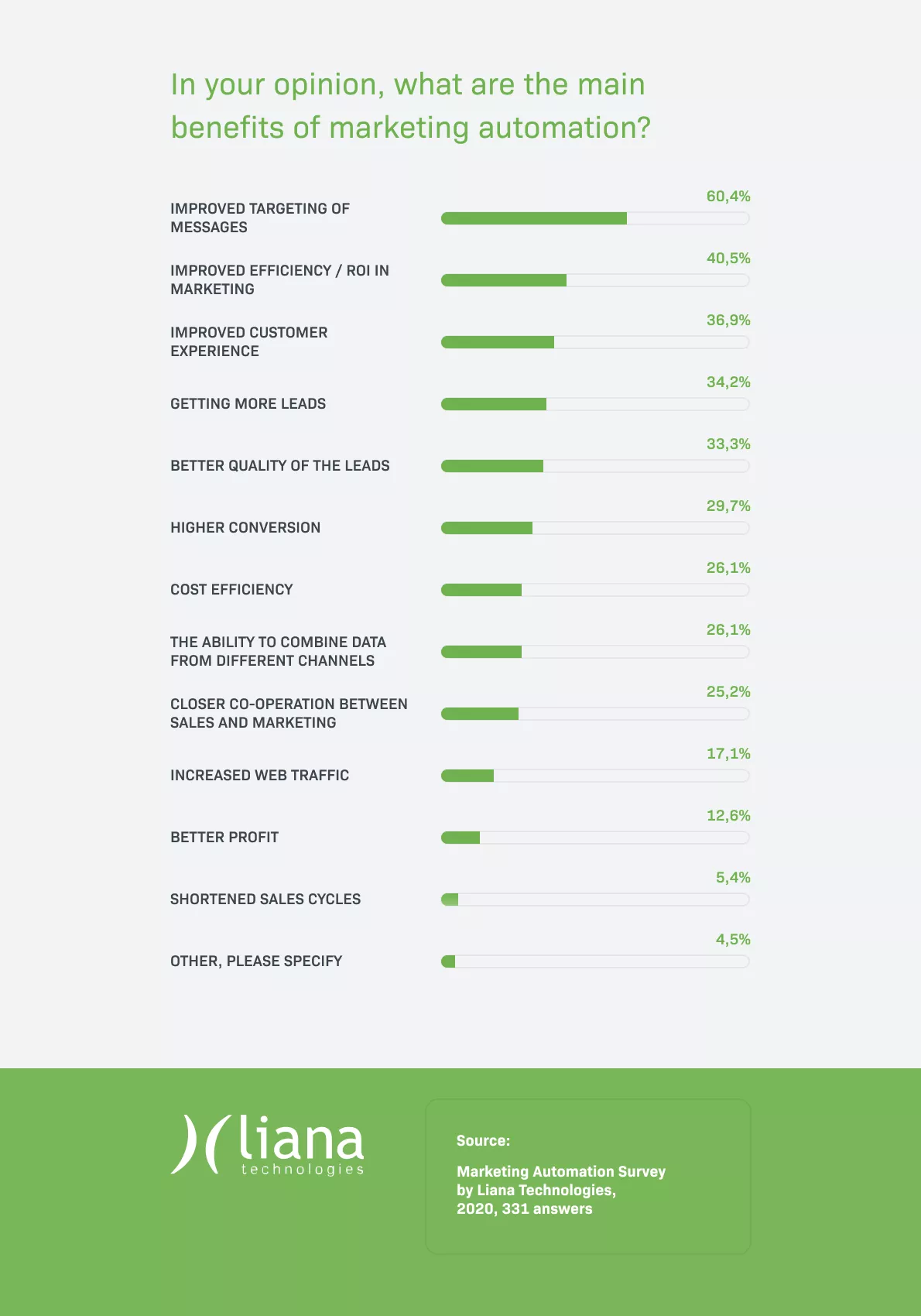
4 Examples of Real Small Businesses Growing Their Own Sales Funnels
Below are just a few examples of small businesses that have used online sales funnels to generate more revenue, bring in higher quality leads, and scale their business.
Apollo Answering Service, LLC
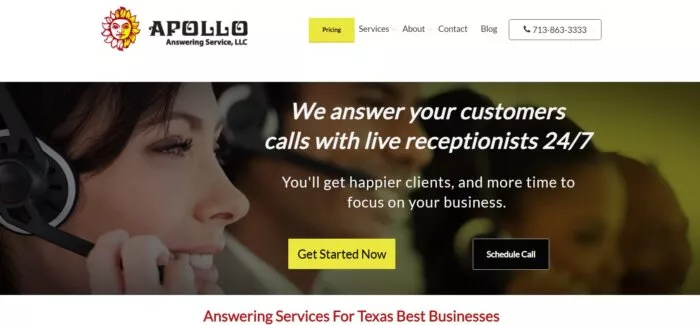
Kelly Cammack, the owner and general manager at Apollo Answering Service in Houston, Texas, called on us to redesign her sales funnel.
If you check out her website now, the blog drives more and more of the traffic these days because she’s investing in the content there.
Previously, the traffic came from a focus on commercial SEO keywords and email marketing.
As a client of Growbo, Apollo Answering Services saw a 400% increase in conversions after working with us to build her funnel.
Take a look at Kelly’s testimonial below which includes a brief overview of her case study story.

Double Your Freelancing
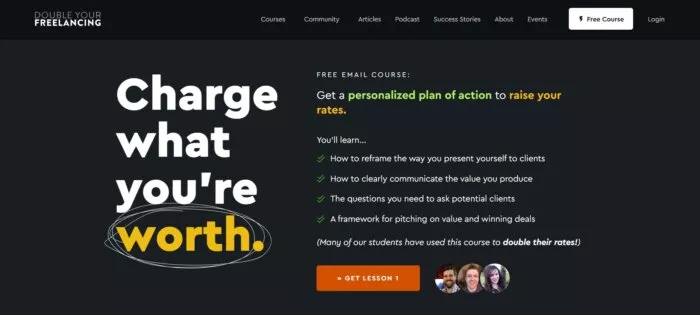
Brennan Dunn at Double Your Freelancing offers expert advice for freelancers and agency owners.
When I interviewed Brennan, he talked about the 7-figure smart sales funnel that he had created. This is probably one of the most sophisticated sales funnels on the internet.
It shows you how advanced you can get with creating an automated
This pop-up was inviting you to participate in his free course. And if you subscribed to the course and then came back to the website later, the site would “remember” you and show you another pop-up bar.
This pop-up bar would give you another offer, this time for his introductory product. So the site remembers you and, based on what stage you’re at in the sales funnel, you’re going to see different offers.
That’s why we call it a “smart” sales funnel.
While this concept is pretty advanced, it helps to further highlight the steps in a successful sales funnel, and how real small businesses are using them.
A Sweet Pea Chef

A Sweet Pea Chef is a food blog founded by Dustin and Lacey Baier.
It introduces the concept of clean eating with recipes, meal plans, and tips for success. The couple sells meal plans and cooking supplies on their website.
The Baiers were having issues with conversions, so they turned to their sales funnel and started over.
Their new sales funnel now includes a lead magnet, introductory offer, inline bump offers (for taking advantage of extra offers), and a core offer.
This four-part funnel isn’t complicated, but it did the trick.

With their old funnel, each month, A Sweet Pea Chef generated just about $200 in revenue.
Once the Baiers implemented their new sales funnel, sales jumped to $2,000 monthly. That’s 10 times more money each month!
Do online sales funnels work?
I think the Baier’s would answer a resounding “Yes!”
Loud Rumor
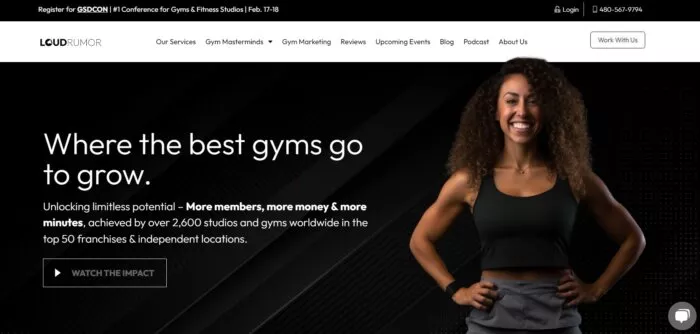
Fitness marketing company Loud Rumor was founded in 2009 by Marjon and Mike Arce in Scottsdale, Arizona.
They started a program for their clients called Fit FLAVER (which is purposely misspelled).
FLAVER is an acronym for Facebook ads, Landing pages, Automation, Video, Email drip, Retargeting.
They tested this new program on one of their clients, a women’s boxing studio, and started marketing towards women who were into fitness.
First, they promoted the boxing studio on Facebook. That link brought the visitor to a landing page, which included a discount.
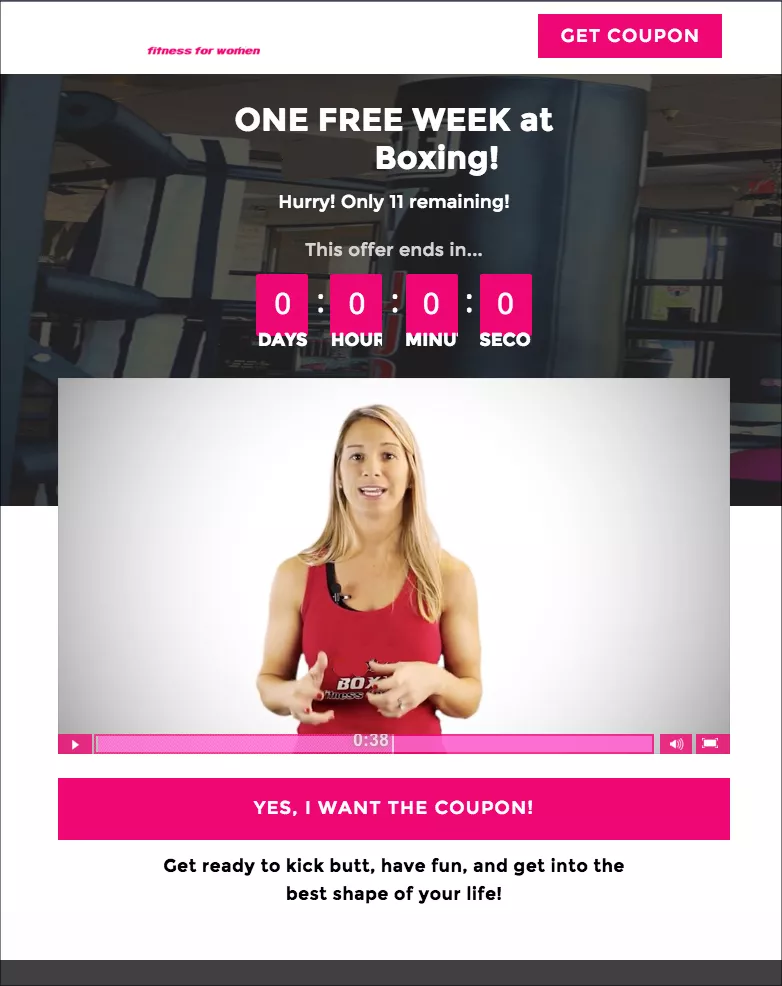
Visitors had to opt in before they could receive the discount. Once they did that, they were taken to a page with an extra bonus. This might be free classes or something similar.
This new sales funnel worked well… really well.
Loud Rumor had 31 new leads for their client in 24 hours. That number more than tripled to nearly 430 leads in 31 days.
Conclusion
In a way, the idea of the online sales funnel being the marketing system you use online is an all-encompassing concept.
You need all components in this system to work together to drive sales.
In fact, that’s just one of the lessons I teach in our Sales Funnel Blueprint training—all you’ll ever need to know to strategically plan and build out your own high-converting online sales funnel (if you have the time to do it).
In any case, we’ve looked at a lot in this article. To review, I showed you:
- The purpose of your online sales funnel is to get your prospect to make an initial or repeat purchase by guiding them through a series of steps that nurture, nudge, and educate.
- The stages of your sales funnels are what I call the 3 F’s—foundation, follow-up, and fuel—those are key components for sales funnel success.
- With an online sales funnel, you can upsell and cross sell your existing customers and increase the value per client dramatically.
- Email funnels are an important part of any online sales funnel. These can be simple or more complicated.
And if you want to automate all of your marketing (including your online sales funnel strategy and implementation) and operations needs, then you must try Growbo: The Future of Business Growth Automation.
Growbo is your AI team to handle all your marketing and business ops needs—at a fraction of the cost and with no hiring headaches.
Learn more here or join our waitlist so that you can be one of the first to automate your growth with Growbo.
Now that you’ve read about my online sales funnel ingredients and how these work, are you ready to start creating your own sales funnel?
If you already have a funnel, which changes are you going to make?
And how has creating your own online sales funnel helped give your business a boost?
Let me know in the comments.
Keep Funnelin’, stay focused,

Image Credit
https://parisa.consulting/whats-the-difference-between-a-funnel-and-a-website/













